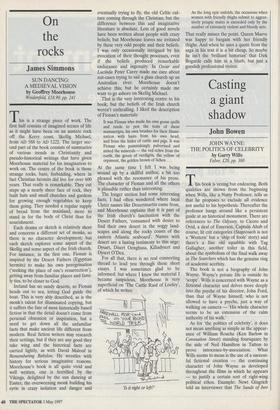On the rocks
James Simmons
SUN DANCING: A MEDIEVAL VISION by Geoffrey Moorhouse Weidenfeld, f18.99, pp. 241 This is a strange piece of work. The first half consists of imagined scenes of life as it might have been on an austere rock off the Kerry coast, Skellig Michael, from AD 588 to AD 1222. The larger sec- ond part of the book consists of summaries of various trends in Christianity and pseudo-historical writings that have given Moorhouse material for his imagination to work on. The centre of the book is those strange rocks, bare, forbidding, where in fact Christian hermits did live for over 600 years. That really is remarkable. They cut steps up a nearly sheer face of rock, they built huts and small churches and gardens for growing enough vegetables to keep them going. They needed a regular supply of bread from the mainland, more to stand in for the body of Christ than for nourishment.
Each drama or sketch is relatively short and concerns a different set of monks, so there is no character development; but each sketch explores some aspect of the Skellig and some aspect of the Irish church. For instance, in the first one, Fionan is inspired by the Desert Fathers (Egyptian hermits) to make his own peregrination (`seeking the place of one's resurrection'), getting away from familiar places and fami- ly ties, to be closer to God.
Ireland has no sandy deserts, so Fionan heads out to sea, letting God guide the boat. This is very ably described, as is the monk's talent for illuminated copying, but it suffers the fate of most historically based fiction in that the detail doesn't come from personal obsession or inspiration, but a need to get down all the unfamiliar facts that make ancient life different from modern. Real fiction writers may research their settings, but if they are any good they take wing and the historical facts are carried lightly, as with David Malouf in Remembering Babylon. He wrestles with history for serious imaginative reasons. Moorhouse's book is all quite vivid and well written, one is horrified by the Vikings, delighted by the sun dancing at Easter, the overweening monk building his eyrie in crazy isolation and danger and eventually trying to fly, the old Celtic cul- ture coming through the Christian; but the difference between this and imaginative literature is absolute. Lots of good novels have been written about people with crazy beliefs; but Moorhouse leaves me irritated by these very odd people and their beliefs. I was only occasionally intrigued by his evocation of their thought processes, even if the beliefs produced remarkable endurance and ingenuity. In Oscar and Lucinda Peter Carey made me care about nut-cases trying to sail a glass church up an Australian river. Moorhouse doesn't achieve this; but he certainly made me want to go ashore on Skellig Michael.
That is the very interesting centre to his book; but the beliefs of the Irish church weren't enthralling. I liked the description of Fionan's materials:
It was Fionan who made his own goose quills and reeds to pen the texts of these manuscripts, his own brushes for their illumi- nation with hairs from his own head, and from the hides of cattle and pigs. It was Fionan who painstakingly pulverised and mixed the minerals — the red ochre from the earth, the green of verdigris, the yellow of orpiment, the golden brown of lichen ...
At the same time I felt I was being wound up by a skillful author, a bit too pleased with the resonance of his prose. The character of Fionan and all the others is plausible rather than interesting.
The longer section had some interesting facts. I had often wondered where local Ulster names like Desertmartin came from, and Moorhouse explains that it is part of the Irish church's fascination with the Desert Fathers, 'consumed with desire to £md their own desert in the soggy land- scapes and along the rocky coasts of the eastern Atlantic seaboard'. Names with desert are a lasting testimony to this urge: Dysart, Disert Oenghusa, Killadysert and Dysert O'Dea.
For all that, there is no real connecting thread to lead you through these short essays. I was sometimes glad to be informed: but where I knew the material I became suspicious. Moorhouse is very superficial on 'The Cattle Raid of Looley', of which he writes: Is it right or left?'
As the long epic unfolds, the occasions when women with friendly thighs submit to aggres- sively priapic males is exceeded only by the number of extremely violent and bloody acts.
That really misses the point. Queen Maeve was happy to bargain with her friendly thighs. And when he uses a quote from the saga in his text it is a bit cheap. So maybe he isn't the 'brilliant historian' that Dirk Bogarde calls him in a blurb, but just a goodish professional visitor.


































































 Previous page
Previous page